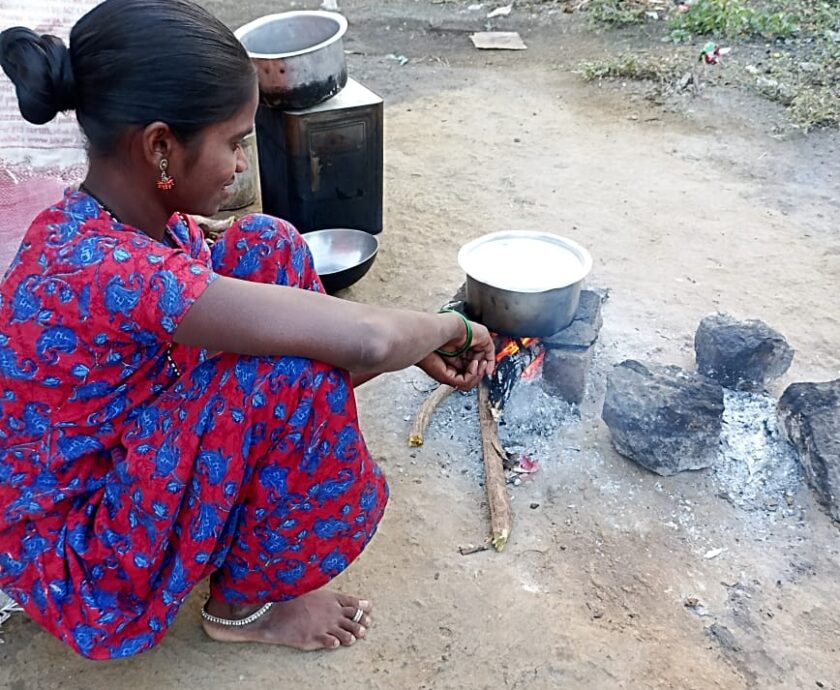Getting familiar with their projects became essential as I was invited to join Aroehan as a trustee. Aroehan works in the Jawhar – Mokhada area of Dist Palghar (in Maharashtra). Take Ahmedabad Highway, travel up to Manor and then turn right to take a road leading to Vikramgad. The road has more potholes than the lunar craters. Perhaps it is a warning sign; the traveller must get ready to receive more severe shocks; I am referring to the living conditions in villages and of villagers.
We finished our work at the Jawhar Office and started for ‘Dharecha Pada’. Pada means a hamlet. A few Padas or hamlets dispersed over a large area makes a village in these scarcely populated hilly terrains of Mokhada. I guessed the population of Dharecha Pada may be less than a thousand. Dr Shuba, Madhuri and I reached Dharecha pada.
“I think she is already inside, I see her two-wheeler” Madhuri said, “A Mata-Baithak is organised here.” ‘Mata Baithak’ is a meeting of women. We alighted from our car in front of a small building. It was a small room, about 18’x18’in size, and it was obvious that the room was made for meetings. Mata Baithak was in progress. About twenty or twenty-five women made the audience, some carried children in their arms. Dr Shuba, Aroehan’s Chief Operating Officer, Madhuri, who supervises a few projects and I joined the meeting. Somebody hurriedly put three chairs for us. Reshma who works with Aroehan, was conducting the meeting.
In Mokhada 169 infants died due to malnutrition in 2006. Anjali Kanitkar and Dr Helen Joseph, moved quickly to establish Aroehan. ‘Aroehan’ is actually an acronym of ‘Action Related to Organisation of Education, Health and Nutrition’ and it is registered as NGO. The initial focus was on malnutrition eradication or health. However, they realised that the multiplicity and inter-contentedness of various factors that contribute to high malnutrition deaths required an integrated approach to the problem resolution.
“This is Mata-Baal Suraksha Card (Health Card of Mother and Child). This is an ‘encyclopaedia’ of pregnancy.” Smile on everybody’s face! Reshma was explaining to the Adivasi (Tribal) women. “It contains all information about a pregnant woman’s registration, delivery and inoculation of the infant.”
Reshma holds Mata-Baithak
“Look at these three colours or three zones.” Reshma was held open the Health Card, and pointed to a diagram. “Three zones – Green, Yellow and Red. Ideally, in which zone your child should be?”
“Green”, a woman replied.
“Good. What needs to be done to make sure that the child is in green zone?” She introduced healthy diet. She was explaining how they should provide ‘Tiranga’ or tri-coloured diet. Tiranga is easily understood because that’s what the national flag is called; it has three colours saffron, white and green. Saffron colour included tomatoes, carrots, white included milk, eggs and rice and green included leafy vegetables. “You don’t have to travel outside your village, all the ingredients of tri-colour diet are available here.”
Note: I was later informed that following is the correct information:
“The food tricolour depicts the following food groups:
Saffron: Body building foods which include all the pulses(dals), meat, eggs and milk – protein sources.
White: Energy giving foods which include all the grains, roots and tubers, oilseeds, ghee, milk products, sugar – carbohydrates and fat sources
Green: Protective foods which include all the leafy vegetables, fruits and fruit vegetables, jaggery, iodised salt, spices – vitamin and mineral sources.
The Ashok Chakra depicts water.”
Dr Shuba turned to me. “Several infants are born as under-weight babies in this Mokhada area. Wrong diet is a problem, but the wrong beliefs and practices about a pregnant woman’s diet is a greater problem. Many tribal women survive only on ‘pej.’ Pej is the water in which rice is boiled. Their diet becomes woefully inadequate. How can the pregnant woman remain healthy and will it not affect the development of the baby? Most of the pregnant women become anaemic, their haemoglobin drops to abysmally low levels.”
Mata Baithak in progress
Internet throws up a study of two researchers from Tata Institute of Social Sciences on malnutrition in Mokhada. ‘In 2005, child malnutrition claimed as many as 718 lives in one single district namely Palghar. Even after a decade of double-digit economic growth, in 2016, more than 600 children died due to under-nutrition in the same district.’ ….. ‘Our study level estimates suggest that 59% of children were stunted.’
“Education of girls usually stops at 7th Class. A 15 or 16-year-old girl is often married in tribal villages. This is quite common. Then she gets pregnant at an age she should not. These are big problems to overcome.”
“I read recently that a fourteen-year-old girl got pregnant in an ‘Ashram School.’
A story in ‘Firstpost’ mentions, ‘In November last year, (2016) the whole state of Maharashtra woke up to a horror — a tribal school in Buldhana was derecognised after reports emerged that girl students are being sexually assaulted there. The incidence only came to light after a girl, who was visiting her parents, complained of stomach-ache and was later found to be pregnant. As the episode unfolded, several other girls came forward complaining of sexual harassment, and at least three of them were pregnant. Eleven people were arrested, including school trustees, the headmaster and a few teachers.
“Ashram Schools provide hostels facility, boys and girls stay there. So, it is not a surprise that a young girl got pregnant. Such cases are not infrequent. They get them married – there is hardly any ceremony – sometimes she moves to the boy’s home, that’s it. Poverty! In a rare case there is a problem if the boy disowns her.”
“Take a look at some women in this meeting (Mata-Baithak). The one with a child in her arms looks under-age. She may be just about sixteen.”
“The are also under-nourished. If you ask them, girls will tell you that they are eighteen years old, but I feel that may not be correct age. There are many bad consequences of an under-age mother – not only at physical but also social level.”
Young Mothers At the Mata-Baithak
Reshma was now discussing the problems faced by women in the pada or hamlet. She spoke about ‘Gram-Sabha’ (Villagers’ Body). ‘People use the forum of the Gram Sabha to discuss local governance and development, and make need-based plans for the village. The Panchayat implements development programs under the overarching mandate, supervision and monitoring of the Gram Sabha. All decisions of the Panchayat are taken through the Gram Sabha and no decision is official and valid without the consent of the Gram Sabha.’
Reshma was persuading all women to organise a Mahila (Women’s) Gram Sabha. The women spoke about the problem of drinking water. Incidentally Mokhada region has a very high rainfall, but the villagers face scarcity of drinking water from march to July.
“You must organise Mahila Gram Sabha to voice your problems. Those will then be raised before Gram Panchayat effectively.” Although Reshma’s words made some impact, the real problem was that tribal women would not speak up in a large gathering. And that was, and remains, a big hurdle to cross.
Reshma turned to the issue of migration of villagers. For the tribal villages this is a huge problem. They can’t survive only on one-crop-agriculture, so they move to cities or towns in search of jobs.
“Migration eats into your life in many ways. Migrating men and women leave behind their aged parents who are left to fend for themselves. Children leave their school. They stay under harsh conditions during the migration period, affecting their health adversely. The entire economy of the village suffers.”
“We have helped farmers produce second crop. Several farmers have been harvesting second crop.”
“Aroehan has decided to take immediate measures to reduce migration of people by 50% in certain area. And that target appears to be almost unsurmountable – you can imagine the magnitude of this problem of migration.”
I was leading my Rotary Club’s project to build two check dams near Bhiwandi. I went to inspect the work when I noticed that a few families of labourers had set up a shade – well, you can’t call it home or even dwelling place – by erecting three feet high sticks and placing a torn saree over it. They were staying under it!
“They come down (climbing down the hills) here in search of a job, and return to their villages for the Holi Festival” the construction supervisor who had engaged those migratory labourers informed me. I was shocked. On my way I noticed a family camping under a tree; once you think of migration, you start spotting those who have migrated.
Migrating tribal families live under horrible conditions
I clicked this photograph. If you wish to grasp the humongous scale of migration, you should travel in Mokhada area. Statistics can provide you information, but sensitization to a problem is the result of seeing migration; statistics fails to sensitise us.
This is a very complex situation. It is multi-dimensional. Any amount of work and support will fall short of eradicating, transforming the situation; that’s my initial assessment. We require long term solutions and some immediate short-term measures, and, of course, a group of committed persons.
There should be no doubt that the Government is the most ineffective organisation, be it of any party. There are many programs and measures which are designed to ameliorate the conditions, but no benefit reaches the people who should be the real beneficiaries. It is heartening that NGOs like Aroehan are seized of the problem.
This horrible situation of poverty, malnutrition, migration, unhealthy practices and low literacy level has undoubtedly resulted from short-sightedness of leaders as well as their preoccupation with their own welfare. Can this be disputed?
Vivek S Patwardhan









